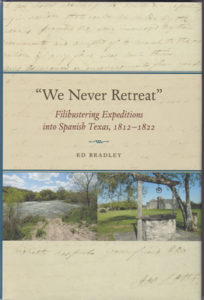
“We Never Retreat”: Filibustering Expeditions into Spanish Texas, 1812-1822 by Ed Bradley presents a fresh look at the earliest Texas expeditions.
Who were the first Anglo settlers in the area now known as Texas? If your answer is Stephen F. Austin and his colony, you’ve missed it by almost two decades. As early as 1800, Phillip Nolan was known to be in Texas, surreptitiously looking for wild mustangs to capture for sale in Kentucky. Many believe his purpose was to claim the region for the United States in a move known as filibustering. Nolan and his contemporaries, including Vice-President Aaron Burr, had visions of exploiting the land for the United States; land that then belonged to Spain. But they were some of the slipperiest characters in U. S. history, so who knows what they were really up to.
President Thomas Jefferson sent not only Lewis and Clark on an exploratory expedition into the newly acquired Louisiana Territory but also Thomas Freeman and Peter Custis to inquire into the Red River environs for scientific purposes. Unfortunately for Jefferson’s men, the Spanish authorities learned of the expedition and curtailed it near Pecan Point in present day Red River County. Freeman and Custis turned around and returned to Natchitoches with marvelous tales of the lands they encountered. Needless to say, the Spanish were now on their guard.
Zebulon Pike was the next to explore the region in 1806. Sent by General James Wilkinson to find the headwaters of the Arkansas and Red Rivers and the Spanish settlement in New Mexico as well as to collect mineral and botanical specimens, Pike and his companions were arrested while in the Sangre de Cristo Mountains west of Santa Fe. There was no doubt in the minds of Spanish authorizes that Americans were very interested in their lands.
For the next fifteen years the United States and Spain teetered on war. Maverick American filibusters did not help the situation. The next interlopers were José Bernardo Gutiérrez and Augustus William Magee who entered Nacogdoches from Natchitoches, Louisiana in 1812 to free Mexico from the tyrannical dictator Spanish king Fernando. But were other objectives motivating the men in the Magee Gutierrez expedition? Much speculation as to the reasons for the semi-successful enterprise has been contemplated after Magee died of illness and the expedition faltered in San Antonio.
Gutierrez led a second invasion into Texas, again on the grounds of freeing Mexico. Again it was unsuccessful but caused further suspicion of United States complicity. Did Presidents James Madison and James Monroe bless the invasions, did they know about them and merely turned a blind eye, or were they truly uninformed? After a severe defeat near San Antonio at the Battle of Medina, there was a brief recess of filibuster activity in Texas.
Dr. James Long, a man of somewhat questionable background, led the final two filibusters into Texas in 1819 and 1821. As time passed fewer men joined the filibuster campaigns, publicity in the United States became less optimistic, and more questions raised.
Ed Bradley wrote “We Never Retreat”: Filibustering Expeditions into Spanish Texas, 1812-1822. I highly recommend it as a welcome look into a period in history often overlooked. It reveals much about the United States foreign policy at a time of high intrigue.
